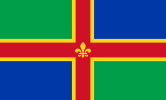Greyfriars, Grayfriars or Gray Friars is a term for Franciscan Order of Friars Minor, in particular, the Conventual Franciscans. The term often to refers to buildings or districts formerly associated with the order.
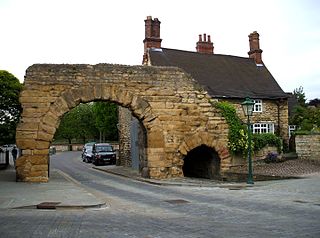
Lindum Colonia was the Latin name for the settlement which is now the City of Lincoln in Lincolnshire. It was founded as a Roman Legionary Fortress during the reign of the Emperor Nero or possibly later. Evidence from Roman tombstones suggests that Lincoln was first garrisoned by the Ninth Legion Hispana, which probably moved from Lincoln to found the fortress at York around c. 71 AD. Lindum was then garrisoned by the Second Legion Adiutrix, which then went on to Chester in 77–78 AD.
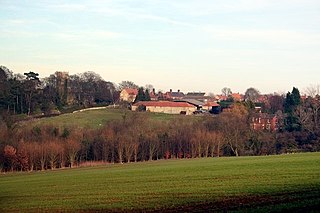
Navenby is a village and civil parish in Lincolnshire, England. Lying 8 miles (13 km) south from the county town of Lincoln and 9 miles (14 km) north-northwest from Sleaford, Navenby had a population of 2,128 at the time of the 2011 census and is a dormitory village for Lincoln. It forms part of the North Kesteven local government district and, in March 2011, it was named as the 'Best Value Village' in England following a national survey.
The Franciscan Friary of Southampton was founded c. 1233. It occupied a south-eastern area of the city, within the walls and adjacent to God's House Tower. The friary was notable for its water supply system, which supplied water for use by the friars themselves and by the other inhabitants of Southampton. The friary was dissolved in 1538 and the last remains were swept away in the 1940s. The site is now occupied by Friary House. Elsewhere, remnants of the extensive water supply system still survive today.

Greyfriars, in Bristol, England, was a Franciscan friary. The name Greyfriars derived from the grey robes worn by the friars. It was founded at some time before 1234, within the town walls and then moved to Lewin's Mead in 1250. The site included extensive gardens surrounded by a stone wall. Following the Dissolution of the Monasteries in the sixteenth century, the premises were leased to the town council in 1541, who desired to use the stone to make repairs to the town walls, and the harbour facilities. In succeeding centuries many different uses have been made of the site, which is currently occupied by an office block and part of Bristol Dental School.

Greyfriars, Stamford was a Franciscan friary in Lincolnshire, England. It was one of several religious houses in Stamford suppressed in the Dissolution of the Monasteries.

Greyfriars Nottingham was a Franciscan friary in Nottinghamshire, England. It was founded c. 1224–1230, and dissolved in 1539 as part of King Henry VIII's Dissolution of the Monasteries. The site of the friary is now occupied by the Broadmarsh Shopping Centre.

Greyfriars, Dunwich was a Franciscan friary in Dunwich in the English county of Suffolk. The friary was founded before 1277 by Richard FitzJohn and his wife Alice and dissolved in 1538. The original site, which had 20 friars in 1277 when it first appears in records, was threatened by coastal erosion and the friary was moved inland in 1289.

Greyfriars, Worcester is a Grade I listed building in Worcester, England. Its location near to a former friary of the Franciscan order of Greyfriars has in the past led to speculation that it was constructed as their guest house, but it is now believed to have been built as a house and brew-house c.1485 for Thomas Grene, brewer and High Bailiff of Worcester from 1493-1497. It has been in the ownership of the National Trust since 1966.

Edward James Willson, F.S.A., (1787–1854) was an English architect, antiquary, architectural writer, and mayor of Lincoln in 1851-2.

In London, the Greyfriars was a Conventual Franciscan friary that existed from 1225 to 1538 on a site at the North-West of the City of London by Newgate in the parish of St Nicholas in the Shambles. It was the second Franciscan religious house to be founded in the country. The establishment included a conventual church that was one of the largest in London; a studium or regional university; and an extensive library of logical and theological texts. It was an important intellectual centre in the early fourteenth century, rivalled only by Oxford University in status. Members of the community at that time included William of Ockham, Walter Chatton and Adam Wodeham. It flourished in the fourteenth and fifteenth century but was dissolved in 1538 at the instigation of Henry VIII as part of the Dissolution of the Monasteries. Christ's Hospital was founded in the old conventual buildings, and the church was rebuilt completely by Sir Christopher Wren as Christ Church Greyfriars after the original church was almost completely destroyed in the Great Fire of London of 1666. The building now standing on the site, designed by Arup Group Limited, is currently occupied by Merrill Lynch.
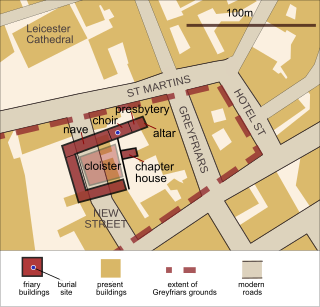
Greyfriars, Leicester, was a friary of the Order of Friars Minor, commonly known as the Franciscans, established on the west side of Leicester by 1250, and dissolved in 1538. Following dissolution the friary was demolished and the site levelled, subdivided, and developed over the following centuries. The locality has retained the name Greyfriars particularly in the streets named "Grey Friars", and the older "Friar Lane".

Newark Friary, also known as Newark Greyfriars, and Newark Observant Friary, was a friary of the reformed "Observant Friars" of the Franciscan Order, located in the town of Newark, Nottinghamshire, England. The friary as founded by Henry Tudor c. 1499, and dissolved by his son, Henry VIII, in 1539.

William Watkins (1834–1926) was an architect who worked in Lincoln, England, and is particularly noted for his Terracotta Revival Architecture.
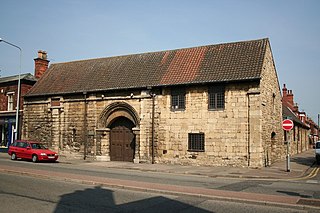
St Mary's Guildhall is a major domestic complex, indicating the highest social status, built in the part of the medieval city of Lincoln, England, known as Wigford. The Guildhall faces directly onto Lincoln High Street and stands to the north of Sibthorp Street. To the south is the late Saxon church of St Peter at Gowts. Stocker describes it as "the only survivor from the small group of the king's town houses which existed in several major towns….St Mary's Guildhall is a domestic complex on a palatial scale, indicating the highest social status, and as such is representative of a little known urban building type".

Michael Drury was an English architect working in Lincoln.

Bellamy and Hardy were an architectural practice in Lincoln, England, that specialised particularly in the design of public buildings and non-conformist chapels. Pearson Bellamy had established his own architectural practice by 1845 and he entered into a partnership with James Spence Hardy in June 1853. Both partners had previously worked for the Lincoln architect William Adams Nicholson. Hardy was described as "Chief Clerk" to Nicholson. Hardy joined Pearson Bellamy immediately after the sudden death of Nicholson. As all known architectural drawings by the practice are signed Pearson Bellamy, it is likely that Bellamy was the architect and Hardy was the administrator in the practice. The partnership lasted until Hardy's death, which was probably in 1891 or 1892. After this Bellamy continued to practice until 1896.

Lincoln Grammar School or Lincoln Free School was formed as the result of the amalgamation of the Lincoln City Free School and the Lincoln Chapter Grammar School. The amalgamation occurred in January 1584, but the two schools may have been effectively working as single school from 1560. In 1574 Lincoln City Corporation had reached an agreement with Robert Monson who was donating the Greyfriars for use as a Grammar School. This was to replace an older City Free school, which had been in scholegate. The exact location of this Free school is uncertain, but scholegate probably refers to Danesgate, but other evidence suggests that the earlier school was close to St Rumbold's church.

The Lincoln Mechanics' Institute or Lincoln and Lincolnshire Mechanics' Institute was founded in Lincoln, England in 1833. It was one of the many Mechanics' institutes which sprang up in the early 19th century and was the first Mechanics' Institute to be founded in Lincolnshire.





















